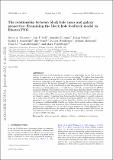Notice
This is not the latest version of this item. The latest version can be found at:https://dspace.mit.edu/handle/1721.1/132566.2
The relationship between black hole mass and galaxy properties: examining the black hole feedback model in IllustrisTNG
| dc.contributor.author | Terrazas, Bryan A | |
| dc.contributor.author | Bell, Eric F | |
| dc.contributor.author | Pillepich, Annalisa | |
| dc.contributor.author | Nelson, Dylan | |
| dc.contributor.author | Somerville, Rachel S | |
| dc.contributor.author | Genel, Shy | |
| dc.contributor.author | Weinberger, Rainer | |
| dc.contributor.author | Habouzit, Mélanie | |
| dc.contributor.author | Li, Yuan | |
| dc.contributor.author | Hernquist, Lars | |
| dc.contributor.author | Vogelsberger, Mark | |
| dc.date.accessioned | 2021-09-20T18:23:05Z | |
| dc.date.available | 2021-09-20T18:23:05Z | |
| dc.identifier.uri | https://hdl.handle.net/1721.1/132566 | |
| dc.description.abstract | <jats:title>ABSTRACT</jats:title> <jats:p>Supermassive black hole feedback is thought to be responsible for the lack of star formation, or quiescence, in a significant fraction of galaxies. We explore how observable correlations between the specific star formation rate (sSFR), stellar mass (Mstar), and black hole mass (MBH) are sensitive to the physics of black hole feedback in a galaxy formation model. We use the IllustrisTNG simulation suite, specifically the TNG100 simulation and 10 model variations that alter the parameters of the black hole model. Focusing on central galaxies at z = 0 with Mstar &gt; 1010 M⊙, we find that the sSFR of galaxies in IllustrisTNG decreases once the energy from black hole kinetic winds at low accretion rates becomes larger than the gravitational binding energy of gas within the galaxy stellar radius. This occurs at a particular MBH threshold above which galaxies are found to sharply transition from being mostly star forming to mostly quiescent. As a result of this behaviour, the fraction of quiescent galaxies as a function of Mstar is sensitive to both the normalization of the MBH–Mstar relation and the MBH threshold for quiescence in IllustrisTNG. Finally, we compare these model results to observations of 91 central galaxies with dynamical MBH measurements with the caveat that this sample is not representative of the whole galaxy population. While IllustrisTNG reproduces the observed trend that quiescent galaxies host more massive black holes, the observations exhibit a broader scatter in MBH at a given Mstar and show a smoother decline in sSFR with MBH.</jats:p> | en_US |
| dc.language.iso | en | |
| dc.publisher | Oxford University Press (OUP) | en_US |
| dc.relation.isversionof | 10.1093/MNRAS/STAA374 | en_US |
| dc.rights | Creative Commons Attribution-Noncommercial-Share Alike | en_US |
| dc.rights.uri | http://creativecommons.org/licenses/by-nc-sa/4.0/ | en_US |
| dc.source | arXiv | en_US |
| dc.title | The relationship between black hole mass and galaxy properties: examining the black hole feedback model in IllustrisTNG | en_US |
| dc.type | Article | en_US |
| dc.relation.journal | Monthly Notices of the Royal Astronomical Society | en_US |
| dc.eprint.version | Original manuscript | en_US |
| dc.type.uri | http://purl.org/eprint/type/JournalArticle | en_US |
| eprint.status | http://purl.org/eprint/status/NonPeerReviewed | en_US |
| dc.date.updated | 2020-11-17T15:46:03Z | |
| dspace.orderedauthors | Terrazas, BA; Bell, EF; Pillepich, A; Nelson, D; Somerville, RS; Genel, S; Weinberger, R; Habouzit, M; Li, Y; Hernquist, L; Vogelsberger, M | en_US |
| dspace.date.submission | 2020-11-17T15:46:10Z | |
| mit.journal.volume | 493 | en_US |
| mit.journal.issue | 2 | en_US |
| mit.license | OPEN_ACCESS_POLICY | |
| mit.metadata.status | Authority Work and Publication Information Needed |
